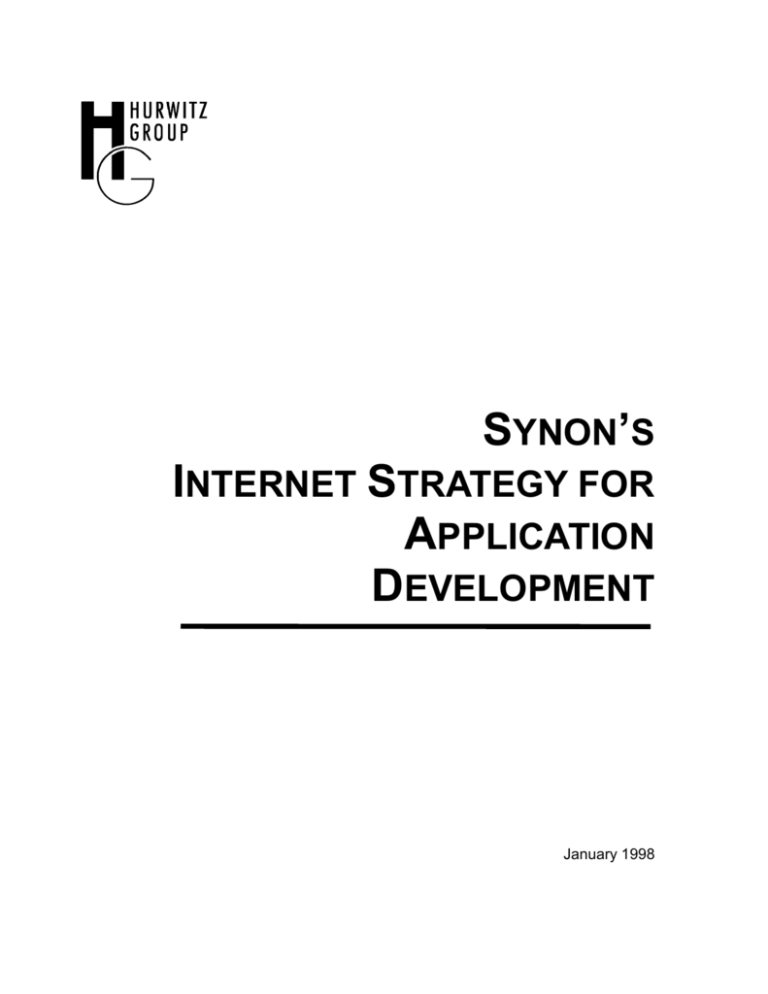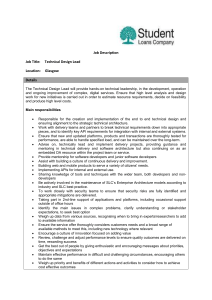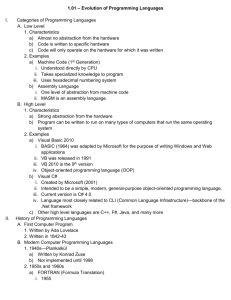
SYNON’S
INTERNET STRATEGY FOR
APPLICATION
DEVELOPMENT
January 1998
Synon’s Internet Strategy for Application Development
is published by Hurwitz Group, Inc.
111 Speen Street, Framingham, MA 01701
Telephone (508) 872-3344; Fax (508) 872-3355
Email address: info@hurwitz.com
Web site: http://www.hurwitz.com
January 1998
Copyright 1998, Hurwitz Group, Inc.
All rights reserved. No part of this report may be reproduced
or stored in a retrieval system, or transmitted in any form or
by any means, without prior written permission.
Synon’s Internet Strategy for Application Development
INTRODUCTION
Organizations are using information technology to create applications that can
streamline business processes, decrease time to market, enhance customer service,
and form other competitive advantages. These applications have become critical to
a company’s survival. With the introduction of the Internet and intranets, companies
now have new opportunities to exploit and new technologies to consider when
developing business applications.
This paper discusses the unique value of web-based applications and the need for
development environments to support new technology deployment options for
applications while still supporting older ones. This paper also sets forth Hurwitz
Group’s criteria for evaluating development environments and evaluates one
vendor, Synon. Synon’s Obsydian is a product that was originally designed for a
single platform (the IBM AS/400) but has now been expanded to support other
platforms. It now also includes web capabilities.
WEB-BASED APPLICATIONS
OPPORTUNITIES OF WEB-BASED APPLICATIONS
Web-based applications have become the new means for companies to gain
competitive advantage. Although true electronic commerce (EC) is just beginning,
corporations must think about how they will restructure the way they do business,
and what this means for internal organizational structures, business processes,
allocation of advertising budgets, and so forth. Some companies will require
a radical change in thinking. EC is an alternative way of doing business —
an additional channel. That doesn’t mean existing channels will go away.
Web-based applications are becoming more sophisticated as organizations gain
experience with Internet technologies. The development of web-based applications
is an ongoing process that builds on previous deployments. The benefits increase as
the applications become more sophisticated. The first web applications followed a
publish-and-subscribe model that provided information to people who requested it.
Now, the industry is moving into a second phase in which interactive applications
provide more information and faster service. So-called “self-service” applications
fall into this category. This next phase provides the capability to perform large
© 1997 Hurwitz Group, Inc.
1
Synon’s Internet Strategy for Application Development
volumes of transactions that run the business. A robust transactions-processing
environment will be able to support true EC on a large scale.
To capitalize on the opportunity for future sales offered by EC, companies will need
to use IT to provide customers with information about their products and services.
This includes IT-enabled advertising, sales, and marketing on the Web; interactive
voice response customer service systems; help desks; customer and product
databases; EDI; electronic catalogs; smart cards; electronic payments; and ATMs.
The Internet also increases the potential reach of marketing messages. The ubiquity
and ease of access to the Internet means that companies can get their marketing
messages out to many more people than has been possible by traditional channels.
As consumers’ buying habits become more accessible, companies will be able to
tailor their marketing messages to individual customers, known as “one-to-one”
or target marketing.
The Internet also enables self-service applications, which lower the cost of doing
business. In the past, companies needed large numbers of people on telephones to
take orders and answer prospective buyers’ questions. Today, many of these tasks
can be accomplished with self-service applications on the Web. These applications
allow the customers to do the work, thus lowering a company’s staffing costs.
The true test of web applications will come from the actual EC transactions being
processed (transaction processing applications). Two major inhibitors to true EC
over the Web have been security and the ability to manage the transaction servers.
As these problems are addressed, Hurwitz Group believes that EC will begin to
accelerate by mid-1998.
BUSINESS VALUE OF WEB-BASED APPLICATIONS
The unique characteristics of web applications provide many benefits for
corporations, including decreased costs. Cost savings will come from several
sources. First, web-based applications are less costly to develop and maintain
because of their use of a stable, standardized infrastructure. In addition, web-based
applications can be implemented more quickly than traditional applications, thereby
reducing time to market.
2
© 1997 Hurwitz Group, Inc.
Synon’s Internet Strategy for Application Development
Because web applications reach more people, the investment per potential customer
is lower than traditional applications. This reduces the cost of sales while greatly
increasing the potential market to which a company’s products are exposed. And, as
mentioned previously, self-service applications are a means of outsourcing work to
reduce costs. For example, a company with a staff of people taking orders could
significantly reduce the number of people required with an application that enables
customers to order their own merchandise from online catalogs. This type of
application can yield quick ROI with greatly reduced ongoing costs.
Another benefit of web-based applications is the increased responsiveness of IT
systems. Applications built on web technologies can be much more responsive than
traditional IT systems. For example, web-based applications can enhance customer
service by providing customers with immediate access to a wealth of information.
Previous to the Web, customers would have to call and wait for documents to be
sent to them. In addition, companies can publish answers to frequently asked
questions on their web sites. This increases customer service and at the same time
reduces staffing requirements.
BUILDING ON PREVIOUS IT INVESTMENTS
Although web-based applications have many benefits, Hurwitz Group believes that
organizations will also continue to develop applications on other architectures,
which also provide unique benefits. New technologies are additive. As with sales
channels, the Web is an additional architecture with which to deploy applications,
not a replacement for host-based or distributed, client/server applications. This
means that companies must have development tools that can create applications for
multiple architectures and platforms.
Organizations are now developing applications that leverage previous IT
investments by bringing together information from multiple sources, such as
legacy mainframes and client/server and web-based architectures. These
applications have two key requirements: Integration of multiple information
sources must be transparent (to end users), and they must have the flexibility to
quickly change applications as business conditions warrant.
© 1997 Hurwitz Group, Inc.
3
Synon’s Internet Strategy for Application Development
CHOOSING AN APPLICATION DEVELOPMENT
ENVIRONMENT
Hurwitz Group believes companies should consider a number of factors when
choosing an application development environment. These factors include ease
of development and maintenance, productivity, flexibility in development and
deployment, and organizational issues such as team development between IT
staff and business users.
LEVERAGING ASSETS THROUGH REUSE
The development environment that a company chooses should be object based
and should enable teams of programmers to share and reuse object code. This allows
developers to create common modules of code for specific business functions and
use them in any application that requires that particular function. Companies can
also reduce overall development costs by leveraging past investments instead of
starting new development projects from scratch. The key is the use of modular
systems that promote practical reuse whenever possible.
ABSTRACTION OF BUSINESS LOGIC (BUSINESS RULES-BASED)
A development environment should allow for the abstraction of business logic
(business-rules based). Developers should be able to create an application by
specifying business rules. In this way, the complexities of the programming
language and its syntax are hidden from developers. This not only makes
developers more productive but also enables them to work better with the
business users they serve.
MULTIPLE DEPLOYMENT PLATFORMS
A development environment should not limit deployment to a single platform.
Users should have a choice of platforms on which the application can be deployed.
Developers should be able to make this choice before or after the application is
designed and developed. An optimal development environment provides
developers with the ability to partition applications and allows individual
components to be deployed on different platforms. This gives an IT organization
great flexibility and results in more efficient utilization of IT resources such as
clients, servers, and databases.
4
© 1997 Hurwitz Group, Inc.
Synon’s Internet Strategy for Application Development
EASE OF APPLICATION MAINTENANCE
More IT dollars are spent maintaining applications than in actual development.
Maintenance includes fixing bugs, enhancing function, and modifying applications
to match changes in business processes. Hurwitz Group believes there are
three important areas for making applications easy to maintain: configuration
management, change management, and flexibility to change application logic.
Configuration management (team coordination, version control). Because
most large applications require teams of developers, it is important for a
development environment to have a means of coordinating the work of the
group. This includes a library for sharing modules of code and version control
for the application components.
Change management. Making changes to large applications can be a difficult
process. The development environment should provide an automated way to
coordinate changes made in different components to ensure that all changes
are applied to the appropriate components at the proper time.
Flexibility to change. Companies are constantly changing organizational
structures and business processes. As a result, the applications supporting
those processes must also be changed. The ability to quickly implement changes
in applications to reflect changes in processes and business rules is critical to
a company’s survival. Therefore, the development environment for these
applications must enable changes to be quickly made, verified, and deployed.
COMPONENT-BASED DEVELOPMENT
Another big plus for a development environment is the ability to create reusable
object components. Preferably, the development environment should support
standard object components based on COM, CORBA, and JavaBeans. These
standard objects should also be customizable by developers. Development
environments that include a library of these components are more advantageous.
Application development environments should also have frameworks, or
templates. These frameworks should model common business tasks that can be
easily customized to a particular company’s needs, therefore cutting development
time significantly. A framework is a basic model, like an outline of a paper. Rather
than starting from scratch, a framework provides a template of business rules that
define a default application model which is then customized.
© 1997 Hurwitz Group, Inc.
5
Synon’s Internet Strategy for Application Development
DEVELOPMENT ENVIRONMENT STRATEGY
When choosing a development environment, most companies face the issue
of whether to buy specialized development tools for specific applications and
deployment platforms (best-of-breed) or get a single environment that can handle all
development needs. The best-of-breed approach has some advantages because these
tools typically create optimized code for a specific type of application or deployment
platform. However, a single environment requires developers to be trained in only
one product, thereby lowering training costs. It also enables IT organizations to be
more flexible when assigning resources since all developers know the environment
and therefore can be more easily shifted from one project to another.
SYNON’S DEVELOPMENT ENVIRONMENT
Synon’s Obsydian is one development environment that provides the capabilities
discussed in this paper. Synon’s first development tools were designed specifically
for the IBM AS/400 platform. However, because most large corporations deploy
applications on multiple platforms, Synon has extended its product line to support
additional platforms such as Unix and Windows NT. To provide customers with
the benefits of the Web, Synon is now extending its development environments
to support development of web-based applications, including support for Java
applets and servlets. Synon’s remaining challenges are to expand to more platforms
and keep its web-based capabilities competitive with vendors that are focused
specifically on web-based development.
OBSYDIAN ARCHITECTURE
Obsydian is a model-based application development environment which generates
native code to implement application designs. It is object based and includes a
library of business objects which can be customized if necessary. Obsydian also
allows developers to create their own reusable objects to fit unique business needs.
Obsidian allows developers to write business rules for the application without
having to be concerned with how the application will be distributed or on which
platforms or networks it will be deployed. This set of business rules becomes the
application model. The application model is beneficial for several reasons:
6
© 1997 Hurwitz Group, Inc.
Synon’s Internet Strategy for Application Development
Back-end code generation for multiple platforms. The application model is
translated into executable code by code generators. These objects can be used
as supplied or customized for a specific purpose. Code for each component of
the application is generated automatically for the platform on which it will be
deployed.
Maintenance of applications. Using application models, changes in business
processes can be easily reflected in the deployed applications by changing the
business rules in the model and regenerating the executable code. Since the
Obsydian environment is object-based, changes are propagated to related
components automatically. This ensures that applications reflect the proper
business processes and keeps changes at a high level of abstraction from
programming code.
Obsydian also provides configuration management, which maintains multiple
versions and coordinates team development. It contains a workgroup repository
that enables teams of developers to share design information from multiple
application models, customized objects, and class libraries.
Component-based development. Portions of applications with specific functions
can be packaged into components representing multiple objects and their
interactions. These components, objects in their own right, are available to
other developers and can be reused in other applications.
Synon’s Internet/Intranet Strategy
Obsydian is being enhanced with JAVATM code generation to support customers’
shift to new technology, allowing existing application designs to be redeployed
on new platforms.
A Phased Approach
Synon will be using a phased approach to add web capabilities to its Obsydian
product line over the next year. Initially, the focus will be on supporting
applications comprising C++ Windows clients with JAVA servers and database
access through Java Database Connectivity (JDBC) (see Figure 1).
© 1997 Hurwitz Group, Inc.
7
Synon’s Internet Strategy for Application Development
Client
Network/
Internet
Obsydian
C++
Client
Server
Obsydian
Java
Function
Obsydian
Java
Runtime
Obsydian
C++
Runtime
Obsydian
Java
Dispatcher
Figure 1. C++ to Java client/server architecture
In phase one, Synon has provided browser access to applications. This enables
customers to leverage existing applications and data while taking advantage of new
technologies, such as the ease of use provided by the browser interface.
In phase two, Synon enhanced the Obsydian development environment to generate
server-based Java code. Server-based Java (“servlets”) has a number of advantages.
First, applications can use the power and other resources provided by servers,
which is more efficient than using Java applets. Servlets also allow 16-bit Windows
3.1 clients, in addition to 32-bit Windows 95 clients, to access 32-bit Java
applications.
Because JAVA is still immature, it is still lacking robust functionality and high
performance. To make up for these limitations, Synon generates C++ clients which
can be downloaded or permanently installed. These C++ clients provide the
benefits of Windows GUI and access the Java servers via TCP/IP .
Phase 3 will add support for Java clients and applets to the Obsydian development
environment. This will enable client portions of applications to run standalone or
run on any browser-enabled device, thus expanding the available clients from just
Windows PCs.
Support for multiple object definitions
Synon supports major object standards such as COM/Active X and intends to
support JavaBeans. Customers can also incorporate CORBA, with extended support
under development.
8
© 1997 Hurwitz Group, Inc.
Synon’s Internet Strategy for Application Development
Support for multiple JAVA versions
Using Java, Synon will be able to support more platforms than it currently supports
natively. As with most standards in the information technology industry, there are
usually multiple, different implementations. This tends to defeat the purpose of the
standard and limit compatibility. Synon has strong partnerships with IBM and
Microsoft, two of the leading vendors promulgating standards. These relationships
will most likely enable Synon to provide support for the most popular Java
implementations.
THE BENEFITS OF SYNON’S APPROACH
Synon’s approach to application development environments has many benefits,
including:
Isolating customers from changes in technology. By combining high-level,
rules-based modeling with object-oriented technology, Obsydian creates an
environment that insulates developers from costly business rules maintenance
and rapid technology changes. Obsydian’s configuration management and
code generators enable components to be designed once and implemented on
many platforms.
Dealing with business issues independent of the deployment platform. For
an application to deliver tangible business benefits, it must reflect the rules
and structure of the business process for which it is intended. Obsydian’s full
life-cycle approach ensures that the business rules identified and modeled at the
beginning of the development cycle appear as logic in the generated applications
at the end of the process. Obsydian enables developers to make modifications to
applications by changing the business rules in the model and regenerating the
code. Synon’s focus on business rules is the right approach. It provides
companies with what they need to ensure that the business rules reflected
in applications are up to date.
Providing a level of abstraction with ready-made components and patterns.
Obsydian provides a high level of abstraction in a number of ways. First, the
application design is written in business rules, rather than a programming
language. In addition, Obsydian applications are developed independent of
underlying network protocols, insulating developers from these complexities.
© 1997 Hurwitz Group, Inc.
9
Synon’s Internet Strategy for Application Development
With Obsydian, Synon introduced a level of abstraction above frameworks,
called patterns. Patterns capture the rules that build frameworks and overcome
some limitations of frameworks, thereby providing more flexibility in
customizing an application model.
Enabling technology migration when appropriate. Until Java is robust enough
to provide all the capabilities needed, Synon is supplementing Java with C++
modules, which are transparently loaded onto clients. Hurwitz Group believes
this is a sound strategy and will enable customers to get the benefits that Java
offers without suffering from its current limitations.
Providing transaction processing for mission-critical applications. Synon
has always concentrated on transaction-processing applications. Its Obsydian
development environment provides high availability options for deployed
applications. For example, Obsydian can generate n-tier applications with
clients communicating simultaneously to multiple, heterogeneous servers. Also,
servers can communicate with other servers. Therefore, backup servers can be
used to enable an immediate switch to an alternate server for any clients in
communication with a server when it fails.
Obsydian’s code generators also build functions that can dynamically switch
tiers. Thus, applications can be assigned to a particular set of servers, be
reconfigured at install time, or can reconfigure themselves at runtime to
respond to, for example, failed or overloaded servers.
CONCLUSION
New information technologies are continually providing new business
opportunities. However, in doing so, these new technologies also present challenges
to IT organizations in terms of how best to deploy these technologies. It is important
that anything newly introduced also leverages previous investments. Having the
right tools to do this is critical. Users should look for vendors that are committed to
introducing new technologies while maintaining customers’ prior investments.
10
© 1997 Hurwitz Group, Inc.
SYNON, INC.
1100 Larkspur Landing Circle
Larkspur, CA 94939
Phone (415) 461 5000
Fax (415) 461 2171
www.synon.com







